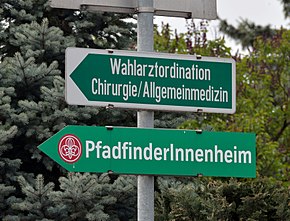This article needs additional citations for verification .(February 2018) |
You can help expand this article with text translated from the corresponding article in German. (February 2018)Click [show] for important translation instructions.
|
| Part of a series on |
| Feminism |
|---|
 |
| Part of a series on |
| Linguistics |
|---|
| |
In German, a medial capital I (German: Binnen-I) is a non-standard, mixed case typographic convention used to indicate gender inclusivity for nouns having to do with people, by using a capital letter 'I' inside the word (Binnenmajuskel, literally "internal capital", i.e. camel case) surrounded by lower-case letters. An example is the word LehrerInnen ("teachers", both male and female). With a lower case I in that position, Lehrerinnen is just the standard word for "female teachers".
Contents
- Background
- U.S. second wave
- Nouns and gender
- History
- Feminist Sprachkritik
- Usage and norms
- Other methods
- Gender star
- See also
- Notes
- Footnotes
- References
- Further reading
- External links
The Binnen-I is a non-standard solution for how to economically express a position of gender equality in one German word, with an expression that would otherwise require three words. Since most English nouns (excluding pronouns) have no grammatical gender, words such as teacher(s), student(s), professor(s), and so on, can be used without implying the gender of the being(s) to which the noun refers. The situation in German, however, is more difficult since all nouns have one of three grammatical genders, masculine, feminine, or neuter.
When used with a noun designating a group of people, a Binnen-I indicates that the intended meaning of the word is both the feminine as well as the masculine forms, without having to write out both forms of the noun. It is formed from the feminine form of a noun containing the -in suffix (singular) or -innen suffix (plural). For example, Lehrerinnen (women teachers) would be written LehrerInnen, with the meaning (men and women) teachers, without having to write out both gender forms, or use the lexically unmarked masculine.

Other gender-inclusive typographic conventions exist in German that perform a similar function, such as the gender star.



